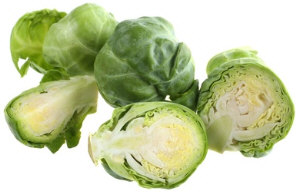Brussels Sprouts
(Rosenkohl or Brüsseler Kohl)
Brussels sprouts belongs to the cabbage family. They look and taste like miniature cabbages. They have small, compact, leafy green heads, usually 1 to 2 inches in diameter.
Brussels sprouts that we know today are relatively young. They were first planted in and around Brussels, Belgium, in 1821. Its popularity as a winter vegetable spread quickly throughout Europe. Today, the major producers of Brussels sprouts include the Netherlands, France, Great Britain, and Germany.
Preparing Brussels Sprouts
To clean and prepare Brussels sprouts, begin by removing the outer leaves. Cut the stems of the sprouts so they are level with the heads. To help the sprouts cook evenly, cut an X in the stem.
Brussels sprouts can be boiled, blanched, steamed, baked, pan-fried, stir-fried, deep fried, used in soups and stews, or eaten raw. They go well with meat dishes, such as steaks, Schnitzel, chicken, lamb, and game.
A traditional way to prepare Brussels sprouts in Germany is to first briefly blanch them. In a pan caramilze some onions with bacon and butter. Add sprouts to the onion mixture and season with salt, pepper, and optionally a pinch of nutmeg. For a richer dish, cream can be added along with sprouts to the onion mixture.
Nutritional Information
Brussels sprouts are low in calorie and nutrient-rich. 3.5 ounces (100g) of raw Brussels sprouts contains:
36 calories
387mg Potassium
31mg Calcium
22mg Magnesium
112mg Vitamin C
Brussels sprouts also contain vitamins B1, B2, B3, B5, and B6, vitamin A, beta carotene, phosphorus, folic acid, iron, and fiber.
Selecting and Storing Brussels Sprouts
When selecting, choose smaller sprouts as these are more flavorful than larger sprouts. Also, choose sprouts that are light green, tightly closed, and show no discolorations. These will be the freshest ones.
Store Brussels sprouts in the refrigerator. It will remain fresh for 2 to 3 days.
|

Photo: © Leonid Nyshko - Fotolia.com
|

